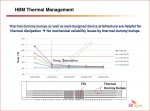http://techreport.com/review/28294/amd-high-bandwidth-memory-explained/2This first-gen HBM stack will impose at least one limitation of note: its total capacity will only be 4GB. At first blush, that sounds like a limited capacity for a high-end video card. After all, the Titan X packs a ridiculous 12GB, and the prior-gen R9 290X has the same 4GB amount. Now that GPU makers are selling high-end cards on the strength of their performance at 4K resolutions, one might expect more capacity from a brand-new flagship graphics card.
When I asked Macri about this issue, he expressed confidence in AMD's ability to work around this capacity constraint. In fact, he said that current GPUs aren't terribly efficient with their memory capacity simply because GDDR5's architecture required ever-larger memory capacities in order to extract more bandwidth. As a result, AMD "never bothered to put a single engineer on using frame buffer memory better," because memory capacities kept growing. Essentially, that capacity was free, while engineers were not. Macri classified the utilization of memory capacity in current Radeon operation as "exceedingly poor" and said the "amount of data that gets touched sitting in there is embarrassing."
Strong words, indeed.
4 Gib wohl sicher..


